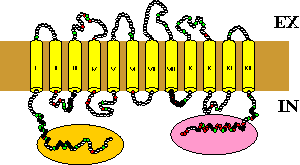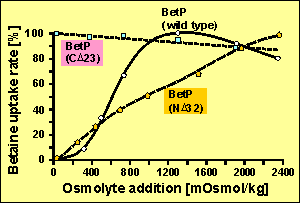|
OSMOSENSING AND OSMOREGULATION
Prof. R. Krämer, Dr. S. Morbach, E. Glees, U. Meyer,
N. Möker, H. Gebhardt, N. Özcan, V. Ott, S. Nicklisch, Philipp Rheilen
The pictures on this page are taken from recent
presentations or lectures. Please feel free to contact
us for further information.
|
|
SCIENTIFIC BACKGROUND
Soil bacteria, such as Corynebacterium glutamicum, possess efficient
mechanisms to overcome osmotic stress causing dehydration (hyperosmotic
stress) or massive water influx (hypoosmotic stress). To cope with hyperosmotic
stress, C. glutamicum accumulates so-called compatible solutes by
uptake or by synthesis. For a fine-tuned response, signal transduction
and integration is necessary for regulation on the level of activity and/or
expression.
|
AIMS
Molecular understanding of activity regulation and osmosensing of osmoregulated secondary carriers for compatible solutes.
Osmostress dependent regulation of transport and biosynthesis processes at the transcriptional and activity level.
Physiological understanding of osmoregulation and cold shock regulation of an soil bacterium.
|
| Osmoregulation
of recombinant BetP proteins

Secondary structure prediction of BetP
|

Activity regulation of wildtype BetP and recombinant
carriers in dependence of the external osmolality.
|
| METHODS AND STRATEGY
The physiological response of C. glutamicum to hyperosmotic stress
is investigated by using a combination of biochemical, molecular and biotechnological
techniques. We have characterized five uptake systems (BetP, EctP, ProP,
LcoP, PutP) and biosynthetic pathways (proline, trehalose) of compatible
solutes, which are involved in the adaptation to hyperosmotic stress.
The characterization of wild type and deletion mutants revealed that the uptake of betaine,
ectoine and proline is preferred over the synthesis of trehalose or proline.
The systems are redundant, since the loss of either all uptake systems or of the biosynthetic pathway
for trehalose or proline has no significant influence on the viability of the cells upon osmotic stress.
Expression profiling with respect to osmodependent genes (RNA hybridization, Northern hybridization, RT-PCR, RACE)
and of the global response to osmotic stress are under investigation to obtain a better understanding of the signal
transduction cascade related to osmotic challenge.
Two corynebacterial carriers, BetP and EctP, are mainly respon-sible for the uptake of betaine after a hyperosmotic shock.
Both are regulated on the level of activity and in each case the hydrophilic N- and C-terminal domains of these transporters are
involved in activity regulation. BetP is shown to comprise also osmosensing and osmoregulatory functions beside its catalytic (transport) activity.
The biochemical properties of the purified carriers BetP and EctP as well as of their hydrophilic extensions, are characterized by using
functional reconstitution in proteoliposomes, transport measurements and spectroscopic methods like CD or surface plasmon resonance (IAsys).
The combination of activity data (sensing properties) and spectroscopy (structural data) is used to obtain more information on osmosensing.
|
| FUNDING |
|
|
| COOPERATION |
-
Prof.
E. Agosin, Universidad de Santiago, Chile
-
Prof.
K. Altendorf, PD Dr. K. Jung, Universität Osnabrück
-
Prof.
E. Bremer, Universität Marburg
-
Prof.
R. Benz, Universität Würzburg
-
Prof.
M. Bott, Forschungszentrum Jülich
-
Prof.
M. Daffe,
Institut de Pharmacologie et de Biologie Structurale, Frankreich
-
Dr.
T. Gensch, Forschungszentrum Jülich
-
Dr.
J. Kunte, Universität Bonn
-
Prof.
J. Wood, University of Guelph (Kanada)
-
Dr. C. Ziegler,
Prof. W. Kühlbrandt, MPI f. Biophysik, Frankfurt
|
|
| SELECTED PAPERS |
-
Wolf, A., Krämer, R. and S. Morbach (2003) Three different pathways for trehalose metabolism in Corynebacterium glutamicum and their significance in response to osmotic stress . Mol. Microbiol. in press
-
Rönsch, H., Krämer, R. and S. Morbach (2003) Impact of osmotic stress on volume regulation, cytoplasmic solute composition and lysine production in Corynebacterium glutamicum MH20-22B. J. Biotechnol. in press
-
Nottebrock, D., Meyer, U., Krämer, R. and S. Morbach (2003) Molecular and biochemical characterization of mechanosensitive channels in Corynebacterium glutamicum. FEMS Letters, 218(2):305-309
[Abstract]
-
Morbach S. and R. Krämer (2002) Body shaping under water stress: Osmosensing and osmoregulation of solute transport in bacteria. Chembiochem 3(5): 384-397
[Abstract]
-
Rübenhagen R, Morbach S, Krämer R (2001). The osmoreactive betaine
carrier BetP from Corynebacterium glutamicum is a sensor for cytoplasmic
K+. EMBO J. 20, 5412-5420.
[Abstract]
-
Rübenhagen R, Rönsch H, Jung H, Krämer R, Morbach S, (2000).
Osmosensor and osmoregulator properties of the betaine carrier BetP from Corynebacterium glutamicum in proteoliposomes. J. Biol. Chem. 275, 735-741.
[Abstract]
-
Peter H, Weil B, Burkovski A, Krämer R, Morbach S, (1998). Corynebacterium glutamicum is equipped with four secondary carriers for compatible solutes: identification, sequencing and characterization of ProP and EctP. J. Bacteriol. 180, 6005-6012.
[Abstract]
-
complete list
|
|
|
|

